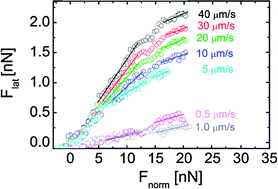Ionic liquid nanotribology: mica–silica interactions in ethylammonium nitrate
Abstract
Colloid probe

- This article is part of the themed collection: Interfaces of Ionic Liquids
* Corresponding authors
a
Discipline of Chemistry, The University of Newcastle, Callaghan, Australia
E-mail:
rob.atkin@newcastle.edu.au
b
Surface and Corrosion Science, Department of Chemistry, Royal Institute of Technology, SE-100 44 Stockholm, Sweden
E-mail:
mark@kth.se
c School of Chemistry, The University of Sydney, NSW, Australia
d Institute for Surface Chemistry, Stockholm, Sweden
Colloid probe

 Please wait while we load your content...
Something went wrong. Try again?
Please wait while we load your content...
Something went wrong. Try again?
O. Werzer, E. D. Cranston, G. G. Warr, R. Atkin and M. W. Rutland, Phys. Chem. Chem. Phys., 2012, 14, 5147 DOI: 10.1039/C1CP23134K
To request permission to reproduce material from this article, please go to the Copyright Clearance Center request page.
If you are an author contributing to an RSC publication, you do not need to request permission provided correct acknowledgement is given.
If you are the author of this article, you do not need to request permission to reproduce figures and diagrams provided correct acknowledgement is given. If you want to reproduce the whole article in a third-party publication (excluding your thesis/dissertation for which permission is not required) please go to the Copyright Clearance Center request page.
Read more about how to correctly acknowledge RSC content.
 Fetching data from CrossRef.
Fetching data from CrossRef.
This may take some time to load.
Loading related content
